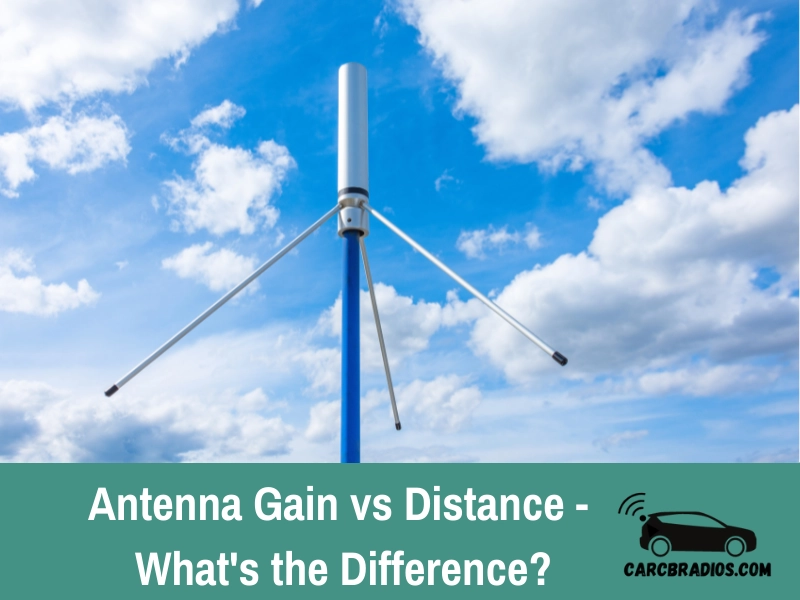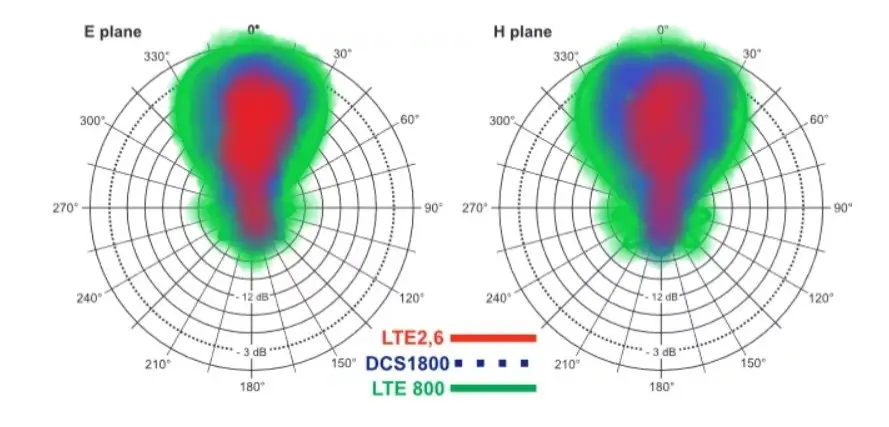By: Jeremy Neisser
As a rule of thumb, antenna gain is the measure of how well an antenna converts RF power from a transmitter to an electrical signal at its output terminals. Distance is generally referred to as transmission line loss or the attenuation of RF signals over a given amount of cable.
There is certainly some correlation between distance and gain; however, there are other factors that also play a role in determining an antenna's signal strength at any particular location.

Antenna Gain: Definition and Purpose
Antenna gain is typically expressed in terms of decibels (dB); the higher the dB rating, the more gain has been achieved. An antenna's gain is a measure of how efficiently it converts RF energy into electrical energy.
For example, assume you have two antennas - Antenna 1 and Antenna 2.
Both are rated at 24 dBi (dB of efficiency). In other words, both antennas are 24 dB more efficient than a dipole antenna.
If you operate Antenna 1 and Antenna 2 at 100 watts from a one-half mile away, Antenna 1 will consume 800 watts and produce 810 watts of RF power in the direction you're transmitting.
Antenna 2 will create 796 watts of RF power in the direction you're sending your signal.
Antenna Gain vs Distance: Transmission Line Loss
There are several sources of transmission-line loss that can affect an antenna's performance, including (but not limited to) the following:
Coaxial cable at each end Connectors Plugs and other hardware Attenuators Twisted pair cable at each end Connectors Filters
The main idea is that if there's a length of cable, some amount of power will be lost.
A 100 ft length of cable may only lose 1 watt; however, when you add another 100ft to it, the loss will increase (theoretically) by 3 dB for every 100 ft increment.
You May Like: How Far Do CB Radios Work
Antenna Gain vs Distance: The Antenna's Radiation Pattern

via https://www.rs-online.com/designspark/antenna-radiation-plots-what-do-they-mean
The radiation pattern is the area (in this case, a hemisphere) in which RF energy is radiated from an antenna.
As you might guess, the further away you are from an antenna, the weaker your signal will be; however, there may be other variables that also affect your signal.
The main point is that a gain figure denotes how much RF power will be transmitted in any particular direction from the antenna, not how much energy or system noise you may receive.
Antenna Gain vs Distance: Why Are Some Antennas Described as Omnidirectional?
Omnidirectional antennas are those with a wide radiation pattern; they are generally used for point-to-point communication and receiving TV signals.
Furthermore, an omnidirectional antenna's reception pattern can be controlled by placing a reflector in front of the radiator (antenna). For example, you want to create a vertical beam that is 3 dB greater than your other beams.
To accomplish this, you place a 12" diameter parabolic reflector in front of the antenna.
This creates a vertical "hot spot" (i.e., 3dB greater than the rest of the pattern) that is approximately 39 feet below the horizon – just what you need to capture video from a very tall tower.
For a further explanation of the different types of antennas, check this article out.
Antenna Gain vs Distance: What Is Back-Lobe Radiation?
Back-lobe radiation occurs when an antenna's main beam is blocked by another object or a portion of the antenna itself.
For example, if you point your base station antenna away from the tower and it has back-lobe radiation, then that energy will be transmitted in the direction of this obstruction.
In general, by applying the formula provided below, you will determine that the gain of your antenna is reduced by approximately 3.7 dB when this happens.
Antenna Gain vs Distance: How Is Radiation Pattern Affected By Efficiency?
Assuming you have an antenna with 20 dBi of efficiency, it will transmit more RF power than an antenna with 10 dBi of efficiency.
As already mentioned, however, this does not mean you will receive more RF power or less noise over a given distance.
Antenna Gain vs Distance: What Is the Diffraction Loss When You Move Closer To an Antenna?
Diffraction loss occurs when there is the inadequate spacing between an antenna and other objects. This can happen on a tower with multiple antennas if one antenna is too close to another or if it rests too close to other structures.
In some cases, this loss may be as high as 1 dB for every inch or foot of distance from the center of the radiating element and its obstruction.
Antenna Gain vs Distance: What Does Overload Mean?
If you have an antenna that is overloaded, it means there is too much RF energy at the point where signals are being received.
This can happen with multi-band antennas or when a tower has too many transmitters on board (common in DAS installations).
The effects of this situation include interference and near-constant retuning of the receiver.
How does antenna gain affect range?
The longer the range, or distance that your signal is transmitted, it will lose energy.
Even if you double the length of cable on an antenna and you halve its efficiency, you are still doubling the power loss over a given length.
-You may like: CB Antenna Range Approximations
Antenna Gain vs Distance: What Are some Useful Formulas?
If you are designing antennas for your wireless site, it will help to know the various formulae that relate to power and range.
Here are some of them (note: P is the total received power):
What is Antenna Gain Formula?
If you want to know how far away from an antenna your signal is being received with a given amount of power at any particular frequency, then use this formula:
The Formula:
Where: Pt = Transmitter power, in watts
Frequency = Frequency of transmission in MHz (megahertz)
S/Gain = Antenna gain in dBi (decibels-by-10), which is expressed as: S/Gain= 10 × log F/D Where: F = 1.25 × Frequency in MHz D = Effective diameter of the antenna, in meters (meters)
The Solution:
In other words, if you have an antenna that is 10 feet wide and it has an efficiency rating of 20 dBi, then its gain will be:
S/Gain= 10 × log(1.25 × 315 MHz)/10 = 2.96 dBi The range of your signal in miles (miles) (ft * 0.3048 = miles) will be: Range= 1/Pt × S/Gain
The Formula:
Where: Pt = Transmitter power in watts
S/Gain = Antenna gain, in dBi
The formula above will tell you how far away from the antenna your signal is being received with a given amount of power at any particular frequency.
The Solution:
You can, however, alter that distance by changing other variables.
For example, if you are trying to determine the transmission range of an antenna over 10 MHz in a free-space environment, then use this equation:
The Formula:
Where: H = Distance in feet (miles * 0.00001372 = ft) D = Effective diameter of the antenna, in meters (ft * 0.3048= miles)
F = Frequency of transmission, in MHz
The Solution:
For example, if you have an antenna and it has an efficiency of 20 dBi, and you are using it at 315 MHz, then the power received will be: Pt = P/20 + Nt
Where: P = Total watts received from the antenna (20-dB signal is half as strong as a 10-dB signal)
Is more antenna gain better?
In general, the answer is no for wireless applications. Having antenna gain will not improve your signal-to-noise ratio or the quality of any other link parameters (unless you are using a directional antenna).
It only means that transmitters have to work harder to establish communications with receivers and vice versa.
As a result, more energy is radiated and the associated costs increase.
Antenna Gain vs Distance: What Should Be the Operating Range of a Wireless Link?
The operating range for any wireless link will be inversely proportional to its signal-to-noise ratio (SNR). This means that if you want your connection to work at longer distances, then you must boost your signal-to-noise ratio.
If you are using a directional antenna, then the radio waves in that direction will be sent with less interference from other signals. This means that your operating range and signal quality increase as well.
What is a good antenna gain?
The general consensus of the industry is that an antenna with a gain rating of 5 dBi would be considered good, while anything higher than 10 dBi would be excellent.
When you are designing your wireless link, it pays to keep in mind the operating range and signal-to-noise ratio. It should also allow for flexibility such as the ability to switch out antennas or use an omnidirectional antenna.
If you are designing wireless links (or antennas) for any of the IEEE 802.11 standards such as B, G, or N, then be sure to keep in mind that you will get a longer operating range if your antennas have less gain.
This is because these standards are designed to operate in dense environments with lots of wireless devices that may share the same frequency band. Hence, they were optimized for operation at short distances (e.g., tens of feet).
In order to cover long distances and maintain good signal quality at high data rates, it is recommended that you use antennas with a lower gain rating within the UNII band (5.15 - 5.25 GHz) or the ETSI 300, 400, and 500 MHz bands used for cellular telephone.
How do I find out my antenna gain?
Antenna manufacturers can tell you the efficiency rating of their antennas when they are new. You will also be able to read this rating on the packaging or in the manual of certain devices.
In order to take into account the loss that an antenna can experience after some time, it is important to know how long you will have access to it before testing and production begins.
How many years your system will be used should also be factored into your design.
Presuming that you get the same model and type of antenna, it is safe to assume that the efficiency will remain constant throughout its lifetime.
Antenna manufacturers can also tell you how much loss a particular antenna has experienced over time when used in typical real-world environments.
This information is usually included in an FCC application or test report. Receive antennas are usually rated for 5 or 10 years of field data, and transmit antennas are rated for 1 or 2 years.
Antenna loss is typically given as a percentage of the efficiency rating a new antenna would have. For example, if an antenna has a rating of 18 dBi at 2 GHz and it has experienced a 5% loss in the field, then its operating range would be around 17.15 dBi.
Does antenna gain affect reception?
The antenna gain rating will determine the operating range for a wireless link. It also has an indirect effect on signal quality.
However, no matter how much power is radiated, if a receiver cannot capture and demodulate the radio waves properly, then there will be no communications.
For example, if you are using 2 dBi antennas at a distance of 10 meters, then you can expect to get around -96 dBm in your receiver.
On the other hand, if you use 10 dBi antennas at a distance of 1 meter, then you can expect to have around -80 dBm at the receiver.
So for this link, the signal level is more than 20 dBm higher at 1 meter than it is at 10 meters.
Therefore, you should always take into account the operating range and link budget when estimating your signal quality.
Antenna gain may be a factor in this formula, but it rarely determines how well a wireless link will perform.
Does SWR affect reception?
In order to evaluate the impact of coupled antenna systems (antennas with a matching network), we will use a matched system that has been placed in free space at 1 meter from the transmit antenna.
In this case, the transmitter power is assumed to be 50W and receiver sensitivity is -93 dBm.
Hence, when you factor in a 30-degree antenna gain along with 4.5 dBi of SWR between the antennas, you can see that the received signal level is 23 dBm less at a distance of 10 meters than it would have been if everything was purely resistive.
This means that your link will only be able to operate at -71 dBm in free space instead of the -59 dBm that the antenna gain alone can yield.
On the other hand, if you change your antennas to a purely resistive load and keep everything else identical, then the received signal level at 10 meters will be around 24 dBm less than it would have been at 1 meter.
This means that your link will only be able to operate at -96 dBm in free space instead of the -72 dBm that the antenna gain alone can yield.
If you are using antennas with SWR, then there will be less power captured by your received antennas when compared to their resistive equivalents.
However, even if all antennas have an SWR of 4:1 on transmit and receive, it is important to remember that each antenna will still capture the power and you cannot neglect the interaction between them.
Does a Yagi antenna improve reception?
The Yagi antenna is an incredibly useful tool for directional communications. As it radiates more signal in the direction of its strongest lobe, there will be reduced multipath effects and fading over the horizon.
However, a Yagi antenna cannot overcome differences in antenna gain and distance that result from the fundamental laws of electromagnetism.
In other words, the Yagi antenna will do nothing to improve the signal quality between two antennas that are 2 dBi apart at 10 meters.
Antennas with a gain mismatch can actually produce a wider angular spread of signals in one direction, thereby increasing diversity at the receiver and reducing fading effects.
This effect is most noticeable when using an isotropic antenna such as an omnidirectional dipole.
The wider the spread of energy, the greater potential for non-line-of-sight communication channels that will allow you to achieve much higher link budgets than would otherwise be possible.

Hi & Welcome!
My name is Jeremy and I have been an avid car nut for many year. My first car was an 1987 Honda CRX. I put in my first Kenwood stereo, amp, 2 10" JLs and a CB Radio in it and have been an avid user of CBs and car radios for years. I'll do my best to share my tips, information and thoughts to help you with whatever question you might have, ABOUT ME
After I graduated from High School, I worked 5 years are Radio Shack and 3 years at Circuit City answering questions and helping customers with various electronics questions.


